Stablecoins are booming, but can Bitcoin still realize its "payment dream"?
Original Title: "Stablecoins: Genius Act Paves Way for Bitcoin to Dominate Global Infrastructure"
Author: Juan Galt
Source: BitCoin Magazine
Compiled by: AididiaoJP, Foresight News
As the GENIUS Act consolidates the status of stablecoins backed by US Treasury bonds, Bitcoin’s decentralized network makes it a more suitable blockchain for global adoption, and it is well-positioned to address the trend of declining demand for US bonds in a multipolar world.
As the world shifts from a US-dominated unipolar order to a multipolar landscape led by BRICS countries, the US dollar faces unprecedented pressure due to declining bond demand and rising debt costs. The GENIUS Act, passed in July 2025, marks a bold US strategy to address this situation by legislatively recognizing stablecoins backed by US Treasury bonds, thereby unlocking massive overseas demand for US bonds.
The blockchains that carry these stablecoins will shape the global economy for decades to come. With its unparalleled decentralization, the privacy of the Lightning Network, and robust security, Bitcoin stands out as the superior choice to drive this digital dollar revolution, ensuring lower conversion costs when fiat currencies inevitably decline. This article explores why the dollar must and will be digitized via blockchain, and why Bitcoin must become its operational rail for the US economy to achieve a soft landing from its global imperial heights.
The End of a Unipolar World
The world is transitioning from a unipolar world order—where the US was the sole superpower, able to sway markets and dominate global conflicts—to a multipolar world, where Eastern alliances can organize independently of US foreign policy. This Eastern alliance is known as BRICS, comprising major countries such as Brazil, Russia, China, and India. The rise of BRICS inevitably leads to a geopolitical reshuffling, challenging the hegemony of the dollar system.
There are many seemingly isolated data points indicating this reorganization of world order, such as the military alliance between the US and Saudi Arabia. The US no longer defends the petrodollar agreement, which once stipulated that Saudi oil would be sold only in dollars in exchange for US military protection in the region. The petrodollar strategy was a major source of dollar demand and had been considered a key to US economic power since the 1970s, but in recent years it has effectively ended. At least since the start of the Ukraine war, Saudi Arabia has begun accepting currencies other than the dollar for oil-related trade.
The Weakness of the US Bond Market
Another key data point in the geopolitical transformation of world order is the weakness of the US bond market, as skepticism about the US government's long-term creditworthiness grows. Some worry about internal political instability, while others doubt whether the current government structure can adapt to a rapidly changing high-tech world and the rise of BRICS.
Elon Musk is reportedly among the skeptics. Musk recently spent several months working with the Trump administration, attempting to restructure the federal government and the country's finances through the Department of Government Efficiency, but abruptly withdrew from politics in May.
Musk shocked the internet when he appeared at a recent summit, saying: "I haven't been to Washington since May. The government is basically hopeless. I appreciate David Sacks' noble efforts... but ultimately, if you look at our national debt... if AI and robots can't solve our debt problem, we're doomed."

If even Musk can't save the US government from financial doom, who can?
Such concerns are reflected in the low demand for US long-term bonds, which manifests as the need to raise interest rates to attract investors. Today, the yield on 30-year US Treasury bonds stands at 4.75%, a 17-year high. According to Reuters, demand for long-term bonds like the 30-year Treasury is also declining, with 2025 demand described as "disappointing."
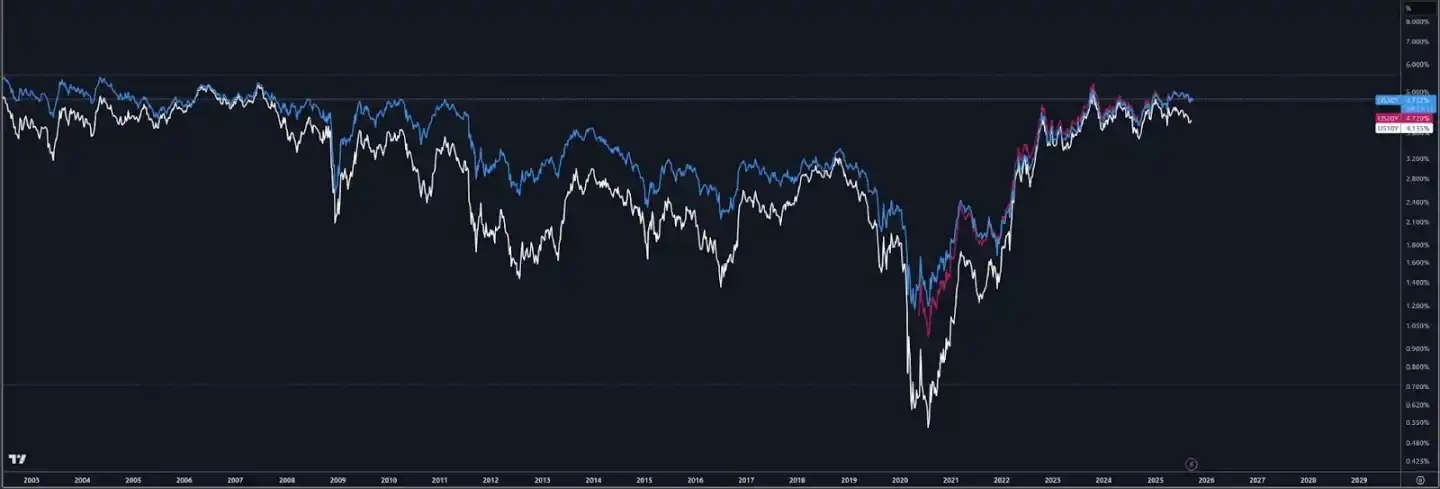
The weakening demand for US long-term bonds has a significant impact on the US economy. The Treasury must offer higher interest rates to attract investors, which in turn increases the interest payments the US government must make on its national debt. Today, US interest payments are approaching $1 trillion per year, exceeding the entire national military budget.
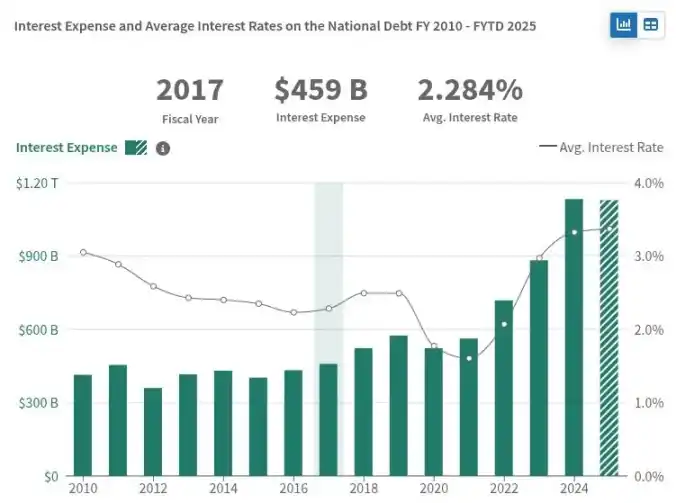
If the US fails to find enough buyers for its future debt, it may struggle to pay its immediate bills and have to rely on the Federal Reserve to purchase this debt, expanding its balance sheet and the money supply. While the effects are complex, it is likely to lead to dollar inflation, further harming the US economy.
How Sanctions Devastated the Bond Market
Further weakening the US bond market was the US's manipulation of its controlled bond market to target Russia in response to its invasion of Ukraine in 2022. When Russia invaded, the US froze Russia's overseas Treasury reserves, which were intended to repay its national debt to Western investors. Reportedly, to force Russia into default, the US also began blocking all attempts by Russia to repay its debts to foreign bondholders.
A female spokesperson for the US Treasury confirmed at the time that certain payments were no longer allowed.
"Today is the deadline for another debt payment by Russia," the spokesperson said.
"Starting today, the US Treasury will not allow any dollar debt payments from Russian government accounts at US financial institutions. Russia must choose whether to exhaust its remaining dollar reserves or new sources of income, or default."
By leveraging its foreign policy sanctions mechanism, the US effectively weaponized the bond market against Russia. But sanctions are a double-edged sword: since then, foreign demand for US bonds has weakened as countries at odds with US foreign policy seek to diversify risk. China has led this trend away from US bonds, with its holdings peaking at over $1.25 trillion in 2013 and accelerating downward since the Ukraine war, now approaching $750 billion.
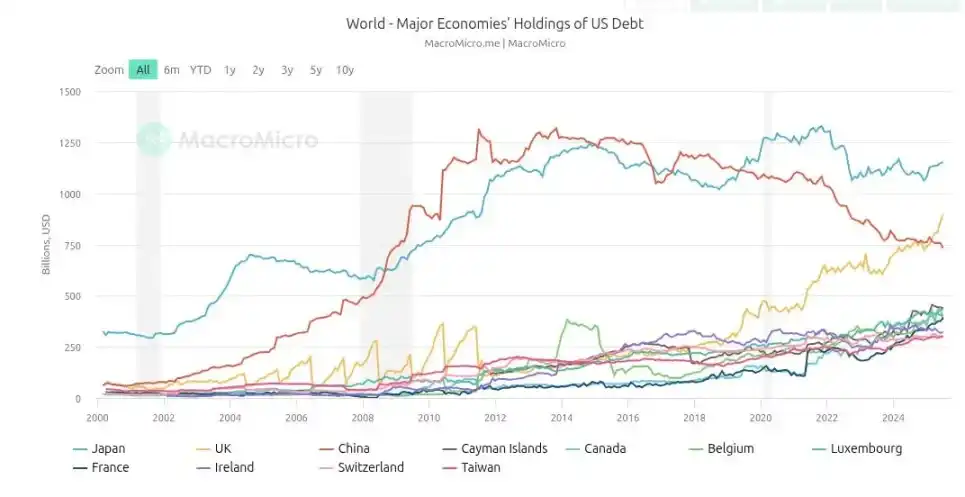
While this event demonstrated the devastating power of sanctions, it also deeply damaged confidence in the bond market. Not only was Russia prevented from repaying its debts under Biden administration sanctions, but investors suffered collateral damage, and freezing its foreign Treasury reserves signaled to the world that if you, as a sovereign nation, defy US foreign policy, all bets are off—including in the bond market.
The Trump administration no longer uses sanctions as its main strategy, as they harm the US financial sector, and has shifted to a tariff-based foreign policy approach. These tariffs have had mixed results so far. While the Trump administration boasts record tax revenues and private sector infrastructure investment domestically, Eastern countries have accelerated their cooperation through the BRICS alliance.
The Stablecoin Playbook
While China has reduced its US bond holdings over the past decade, a new buyer has emerged and quickly risen to the top of the power structure. Tether, a fintech company born in the early days of Bitcoin, now holds $171 billion in US bonds, nearly a quarter of China's holdings and more than most other countries.
Tether is the issuer of the most popular stablecoin, USDT, with a circulating market cap of $171 billion. The company reported a Q1 2025 profit of $1 billion, with a simple yet excellent business model: buy short-term US bonds, issue USDT tokens backed 1:1, and pocket the US government's coupon interest. With 100 employees at the start of the year, Tether is said to be one of the most profitable companies per capita in the world.

Circle, the issuer of USDC and the second most popular stablecoin on the market, also holds nearly $50 billion in short-term Treasury bills. Stablecoins are used worldwide, especially in Latin America and developing countries, as alternatives to local fiat currencies, which suffer from far more severe inflation than the dollar and are often hindered by capital controls.
Today, the transaction volume processed by stablecoins is no longer a niche, geeky financial toy—it has reached trillions of dollars. A 2025 Chainalysis report notes: "Between June 2024 and June 2025, USDT processed over $1 trillion per month, peaking at $1.14 trillion in January 2025. Meanwhile, USDC’s monthly volume ranged between $1.24 trillion and $3.29 trillion. These volumes highlight the continued central role of Tether and USDC in crypto market infrastructure, especially in cross-border payments and institutional activity."
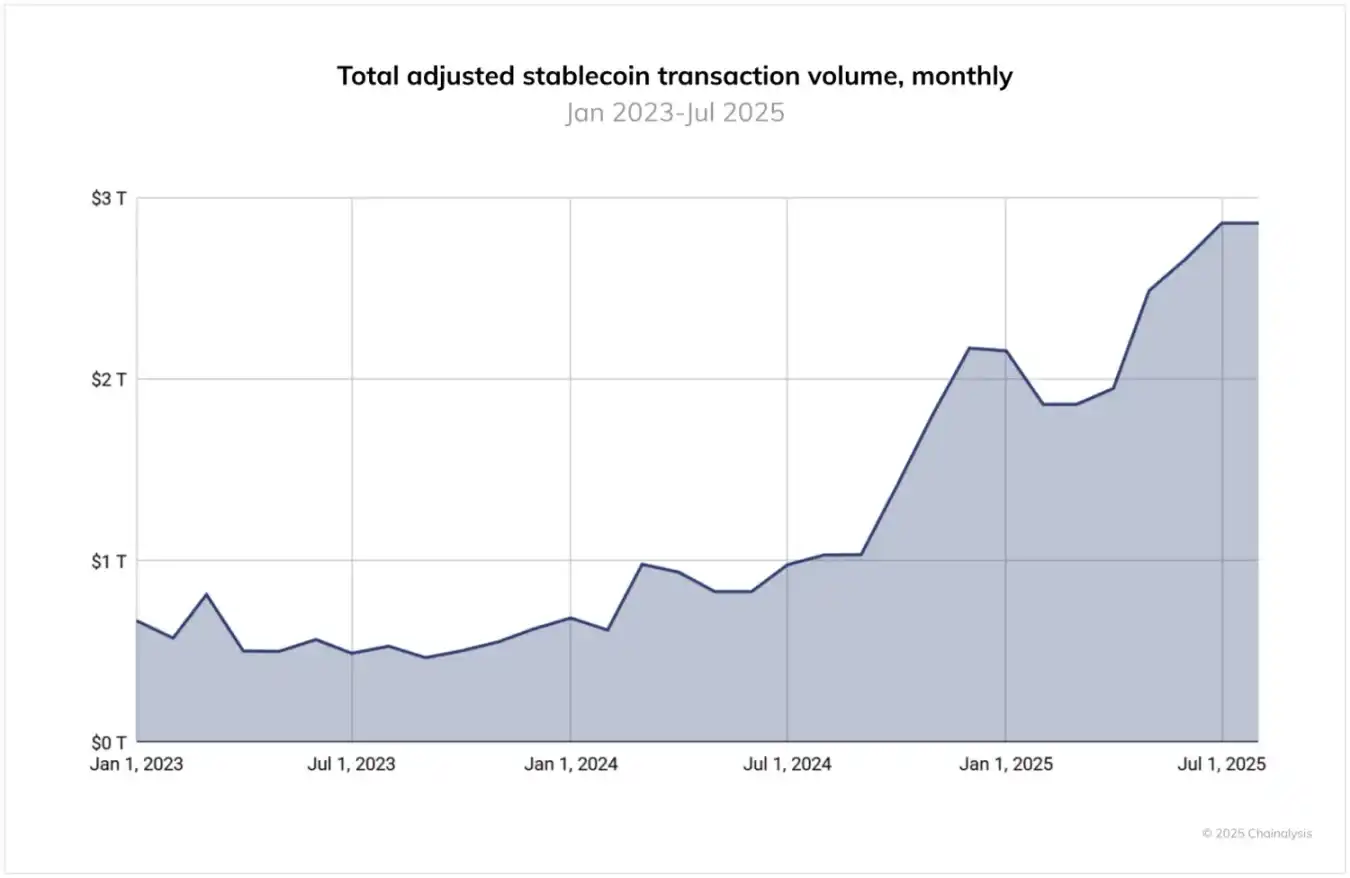
For example, according to a 2024 Chainalysis report focusing on Latin America, the region accounted for 9.1% of total crypto value received between 2023 and 2024, with annual usage growth rates between 40% and 100%, and over 50% of that being stablecoins—demonstrating strong demand for alternative currencies in the developing world.
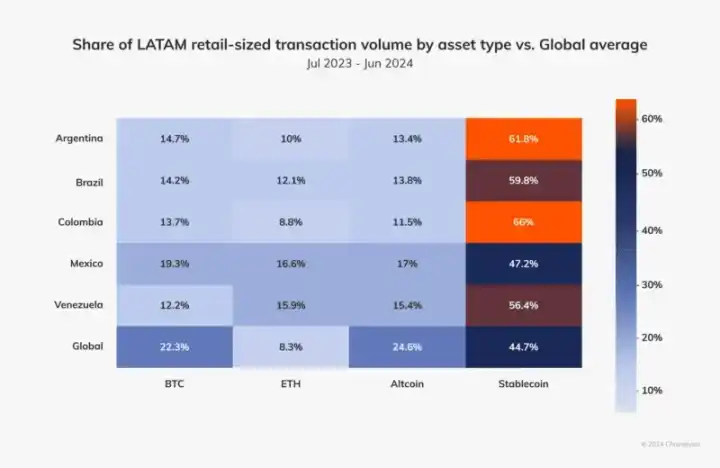
The US needs new demand for its bonds, and this demand exists in the form of demand for dollars, as most people in the world are stuck with fiat currencies far inferior to the US dollar. If the world shifts to a geopolitical structure that forces the dollar to compete on equal footing with all other fiat currencies, the dollar may still be the best among them. Despite its flaws, the US remains a superpower with astonishing wealth, human capital, and economic potential, especially compared to many small countries and their questionable pesos.
Latin America has shown a deep desire for dollars, but there are supply issues, as local countries resist traditional banking dollar channels. In many countries outside the US, obtaining a dollar-denominated account is not easy. Local banks are usually strictly regulated and answer to local governments, which have an interest in maintaining their own pesos. After all, the US is not the only government that knows how to print money and maintain its currency’s value.

Stablecoins solve both problems: they create demand for US bonds and can transmit dollar-denominated value to anyone, anywhere in the world.
Stablecoins leverage the censorship-resistant nature of their underlying blockchains, a feature local banks cannot offer. Thus, by promoting stablecoins, the US can reach untapped foreign markets, expand its demand and user base, while also exporting dollar inflation to countries with no direct influence on US politics—a long-standing tradition in dollar history. Strategically, this sounds ideal for the US and is a simple extension of how the dollar has operated for decades, just built on new financial technology.
The US government understands this opportunity. According to Chainalysis: "The regulatory landscape for stablecoins has changed significantly over the past 12 months. While the US GENIUS Act has not yet taken effect, its passage has spurred strong institutional interest."
Why Stablecoins Should Surpass Bitcoin
The best way to ensure Bitcoin helps the developing world escape mediocre fiat is to ensure the dollar uses Bitcoin as its operational rail. Every dollar stablecoin wallet should also be a Bitcoin wallet.
Critics of the Bitcoin-dollar strategy will say this betrays Bitcoin’s libertarian roots—Bitcoin was meant to replace the dollar, not enhance it or bring it into the 21st century. However, this concern is largely US-centric. It’s easy to denounce the dollar when you’re paid in dollars and your bank account is denominated in dollars. It’s easy to criticize it when 2-8% dollar inflation is your local currency. In too many countries outside the US, 2-8% annual inflation would be a blessing.
A large portion of the world’s population suffers from fiat currencies far worse than the dollar, with inflation rates ranging from low double digits to high double digits, even triple digits. That’s why stablecoins have already achieved mass adoption in the third world. The developing world needs to get off the sinking ship first. Once they’re on a stable boat, they may start looking for ways to upgrade to the Bitcoin yacht.
Unfortunately, although most stablecoins originally started on Bitcoin, they do not run on Bitcoin today, and this technical reality creates significant friction and risk for users. Today, most stablecoin volume runs on the Tron blockchain, a centralized network operated by Justin Sun on a handful of servers, making it easy for foreign governments that dislike dollar stablecoins spreading within their borders to target him.
Most blockchains that stablecoins run on today are also completely transparent. Public addresses serving as user accounts are openly traceable, often linked to users’ personal data by local exchanges, and easily accessible to local governments. This is a lever foreign countries can use to push back against the spread of dollar-denominated stablecoins.
Bitcoin does not have these infrastructure risks. Unlike Ethereum, Tron, Solana, etc., Bitcoin is highly decentralized, with tens of thousands of nodes worldwide, and has a robust peer-to-peer network for transmitting transactions, easily bypassing any bottlenecks or obstacles. Its proof-of-work layer provides a separation of powers not found in other proof-of-stake blockchains. For example, Michael Saylor, despite holding a large amount of Bitcoin—3% of total supply—has no direct voting power in the network’s consensus politics. For Vitalik and Ethereum’s proof-of-stake consensus, or Justin Sun and Tron, the situation is different.
Furthermore, the Lightning Network built on Bitcoin unlocks instant transaction settlement, benefiting from the security of Bitcoin’s underlying blockchain. It also provides significant privacy for users, as all Lightning transactions are off-chain by design and leave no trace on the public blockchain. This fundamental difference in payment methods allows users to enjoy privacy when remitting funds to others. It reduces the number of potential privacy violators from anyone who can view the blockchain to a handful of entrepreneurs and tech companies, at worst.
Users can also run their own Lightning nodes locally and choose how to connect to the network, and many do, putting privacy and security in their own hands. These features are not seen in most blockchains used for stablecoins today.
Compliance policies and even sanctions can still be applied to dollar stablecoins, whose governance is anchored in Washington, using the same analytics and smart contract-based methods used today to prevent criminal use of stablecoins. Fundamentally, the dollar cannot be decentralized—it is designed to be centralized. However, if most stablecoin value is transferred via the Lightning Network, user privacy can also be maintained, protecting users in developing countries from organized crime or even their own governments.
Ultimately, users care about transaction fees and the cost of transferring funds, which is why Tron still dominates the market. However, with USDT launching on the Lightning Network, this may soon change. In a Bitcoin-dollar world order, the Bitcoin network will serve as the medium of exchange for the dollar, while the dollar will remain the unit of account for the foreseeable future.
Can Bitcoin Withstand All This?
Critics of this strategy also worry that the Bitcoin-dollar strategy may impact Bitcoin itself. They wonder whether placing the dollar on top of Bitcoin will distort its underlying structure. The most obvious way a superpower like the US government might try to manipulate Bitcoin is by forcing it to comply with sanctions regimes, which theoretically could be done at the proof-of-work layer.
However, as mentioned earlier, the sanctions regime has arguably peaked, giving way to the tariff era, which seeks to control the flow of goods rather than funds. This post-Trump, post-Ukraine war shift in US foreign policy strategy actually relieves pressure on Bitcoin.

As Western companies like BlackRock, and even the US government, continue to adopt Bitcoin as a long-term investment strategy—or, in President Trump’s words, as a "strategic Bitcoin reserve"—they also begin to align themselves with the future success and survival of the Bitcoin network. Attacking Bitcoin’s censorship resistance would not only undermine their investment in the asset but also weaken the network’s ability to deliver stablecoins to the developing world.
In a Bitcoin-dollar world order, the most obvious compromise Bitcoin must make is to give up the unit of account dimension of money. This is bad news for many Bitcoin enthusiasts, and rightly so. The unit of account is the ultimate goal of hyperbitcoinization, and many users already live in that world today, making economic decisions based on the ultimate impact on their satoshi holdings. However, for those who understand that Bitcoin is the soundest money ever, nothing can truly take that away. In fact, belief in Bitcoin as a store of value and medium of exchange will be strengthened by this Bitcoin-dollar strategy.
Sadly, after 16 years of trying to make Bitcoin as ubiquitous a unit of account as the dollar, some realize that in the medium term, the dollar and stablecoins are likely to fulfill that use case. Bitcoin payments will never disappear; companies led by Bitcoin enthusiasts will continue to rise and should continue to accept Bitcoin as payment to build their Bitcoin reserves. But for the next few decades, stablecoins and dollar-denominated value are likely to dominate crypto trade.
Nothing Can Stop This Train
As the world continues to adapt to the rise of Eastern powers and the emergence of a multipolar world order, the US may have to make tough and critical decisions to avoid a prolonged financial crisis. In theory, the US could cut spending, pivot, and restructure to become more efficient and competitive in the 21st century. The Trump administration is certainly trying to do so, as shown by the tariff regime and other related efforts to bring manufacturing back to the US and cultivate local talent.
While several miracles might solve the US’s fiscal woes—such as sci-fi-level labor and intelligent automation, or even the Bitcoin-dollar strategy—ultimately, even putting the dollar on the blockchain won’t change its fate: to become a collector’s item for history buffs, a relic for museums, a rediscovered token of a bygone empire.
The dollar’s centralized design and dependence on US politics ultimately doom its fate as a currency, but if we’re realistic, its demise may not be seen for 10, 50, or even 100 years. When that moment truly arrives, if history repeats itself, Bitcoin should be there as the operational rail, ready to clean up the mess and fulfill the prophecy of hyperbitcoinization.